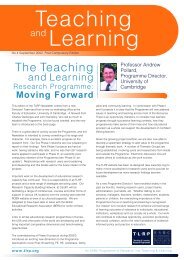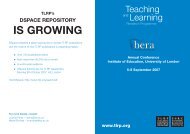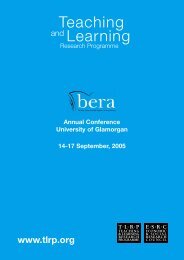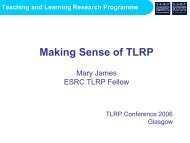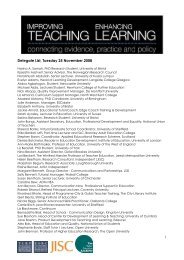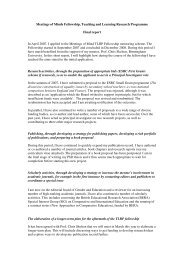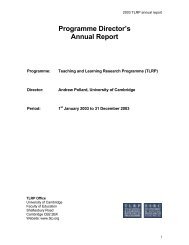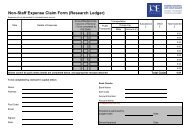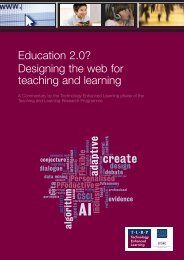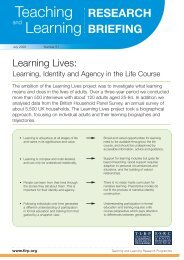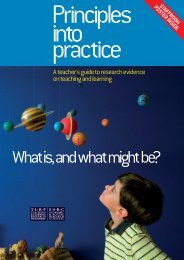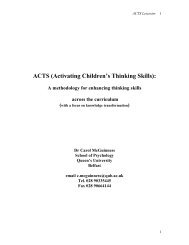These complementary strategies have not just established relationships between inventory subscales,they have also indicated how <strong>teaching</strong> <strong>and</strong> <strong>assessment</strong>, <strong>and</strong> other aspects of the <strong>teaching</strong><strong>learning</strong>environment, influence students’ ways of studying <strong>and</strong> the levels of underst<strong>and</strong>ing reached.This paper begins with a brief summary of the main concepts which form the coherent framework.Other research will be used to show the influences on <strong>learning</strong> of the interaction between students<strong>and</strong> the <strong>teaching</strong>-<strong>learning</strong> environment. In this way, the process of knowledge transformation willbe explored <strong>and</strong> used to suggest relevance beyond higher education.Conceptions of <strong>learning</strong> <strong>and</strong> approaches to studyingUsing interview methodology, the broadest of the concepts in research on student <strong>learning</strong> camefrom the responses of adults who were asked “What do you mean by ‘<strong>learning</strong>’?”. As in all thisresearch, the variation in people’s responses provided the research findings. They had very differentconceptions of <strong>learning</strong> (Säljö, 1979; Marton & Säljö, 1997), which involved a hierarchy which hasparallels with the developmental trend in students’ thinking – their epistemological levels -identified earlier by Perry (1970) (see Figure 1). Perry found that students initially saw <strong>learning</strong>mainly as a matter of memorising <strong>and</strong> reproducing knowledge in ways acceptable to the teacher.During their time at university, students gradually began to recognise that <strong>learning</strong> was morerewarding when they sought personal meaning by transforming information <strong>and</strong> ideas in terms oftheir own previous knowledge <strong>and</strong> underst<strong>and</strong>ing.Figure 1Conceptions of <strong>learning</strong> <strong>and</strong> epistemological levelsDualismEpistemological levelRelativismKnowledgeseenas absoluteMultipleperspectives,own opinionKnowledgeseen asprovisionalEvidence usedto reason withCommitmentto a reasonedinterpretationExp<strong>and</strong>ing awareness <strong>through</strong> a nested hierarchy of conceptionsReproducingConceptions of <strong>learning</strong>TransformingAcquiringinformationBuilding upknowledgeroutinelyApplyingknowledge<strong>and</strong> skillsMaking senseof ideas <strong>and</strong>the real worldDevelopingas a person2
Paper to be presented at TLRP Conference, Leicester, November, 2000The epistemological level or conception of <strong>learning</strong> students have reached substantially affects theways in which they tackle everyday academic tasks, which have been described in terms ofapproaches to <strong>learning</strong> <strong>and</strong> studying. The starting point of this research was an investigation intohow students went about reading (Marton & Säljö, 1976; Marton, Hounsell & Entwistle, 1997).Students were asked, individually, to read an academic article <strong>and</strong> were told that they would beasked questions on it afterwards. It became clear from the transcripts that students had interpretedthis instruction very differently, <strong>and</strong> their ability to answer questions about the meaning of the textdepended on how they had decided to tackle the task. Some students had sought a thoroughunderst<strong>and</strong>ing of the author’s message, while others had relied on ‘question-spotting’ - <strong>learning</strong> justthose pieces of information expected to come up in the test. This distinction was gradually refined<strong>through</strong> qualitative analysis to produce a descriptive concept with two categories - <strong>deep</strong> <strong>and</strong> surfaceapproaches to <strong>learning</strong> – in which a specific intention brings into play <strong>learning</strong> process which leadto qualitatively different <strong>learning</strong> outcomes.In the <strong>deep</strong> approach, the intention to extract meaning produces active <strong>learning</strong> processes thatinvolve relating ideas <strong>and</strong> looking for patterns <strong>and</strong> principles on the one h<strong>and</strong> (a holist strategy -Pask, 1976, 1988), <strong>and</strong> using evidence <strong>and</strong> examining the logic of the argument on the other(serialist). The approach also involves monitoring the development of one’s own underst<strong>and</strong>ing(Entwistle, McCune & Walker, 2000). In the surface approach, in contrast, the intention is just tocope with the task, which sees the course as unrelated bits of information which leads to much morerestricted <strong>learning</strong> processes, in particular to routine memorisation.Interviews on everyday studying drew attention to the pervasive influence of <strong>assessment</strong> procedureson <strong>learning</strong> <strong>and</strong> studying. They suggested the need for an additional category - strategic approach -in which the intention is to achieve the highest possible grades by using organised study methods<strong>and</strong> good time-management (Entwistle & Ramsden, 1983). This approach also involves monitoringone’s study effectiveness (Entwistle, McCune & Walker, 2000) <strong>and</strong> an alertness to the <strong>assessment</strong>process, aspects which are akin to metacognitive alertness <strong>and</strong> self-regulation (Vermunt, 1998;Pintrich & Garcia, 1994). Interviews with students suggest that strategic students have two distinctfocuses of concern - the academic content <strong>and</strong> the dem<strong>and</strong>s of the <strong>assessment</strong> system. The interest inthe content is typical of a <strong>deep</strong> approach, but the alertness to <strong>assessment</strong> requirements is typicallystrategic (Entwistle, 2000). Whereas the distinction between <strong>deep</strong> <strong>and</strong> surface approaches wasderived from analyses which focused on extracting meaning from text, the strategic approach,together with its opposite - the apathetic approach (Tait & Entwistle, 1996) - indicate how studentsact in everyday study situations. They are therefore better described as approaches to studying.The research on student <strong>learning</strong> began with interviews, but soon led to the construction ofinventories to assess the predominant approach being used. One such inventory was the Approachesto Studying Inventory (Entwistle & Ramsden, 1983) which has led recently to ASSIST (Approaches<strong>and</strong> Study Skills Inventory for Students – Tait, Entwistle & McCune, 1998). The way in which thevarious sub-scales of this most recent inventory come together to define the characteristics of thesuccessful student is illustrated in Figure 2. The links shown there also indicates that the <strong>deep</strong>,strategic approach, without any elements of surface apathetic, is generally associated with successfulacademic performance (Entwistle, 2000).3



